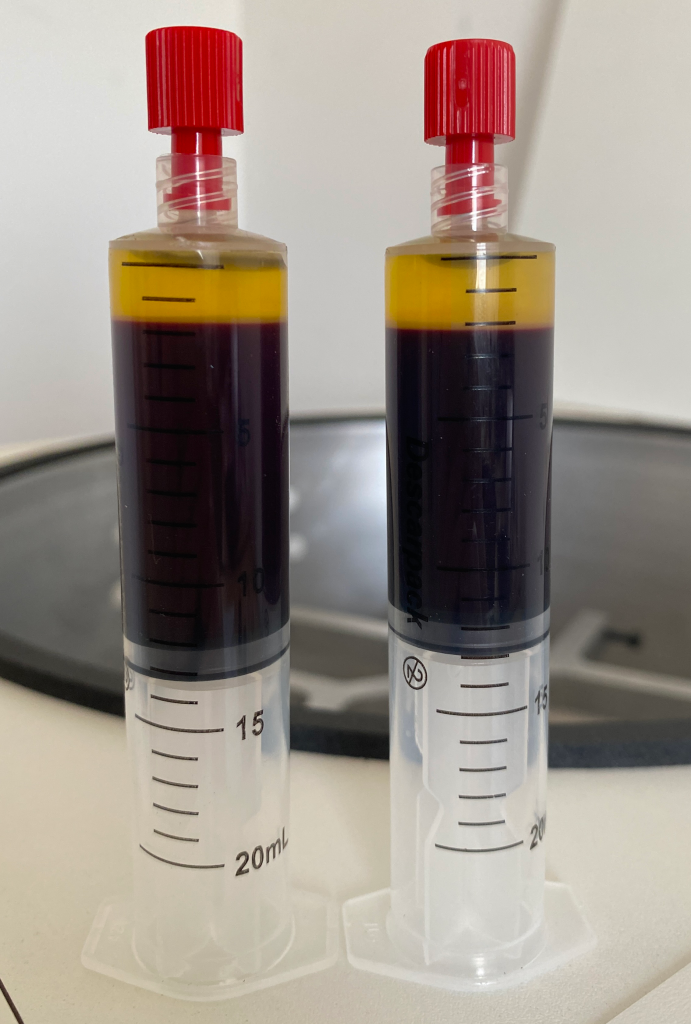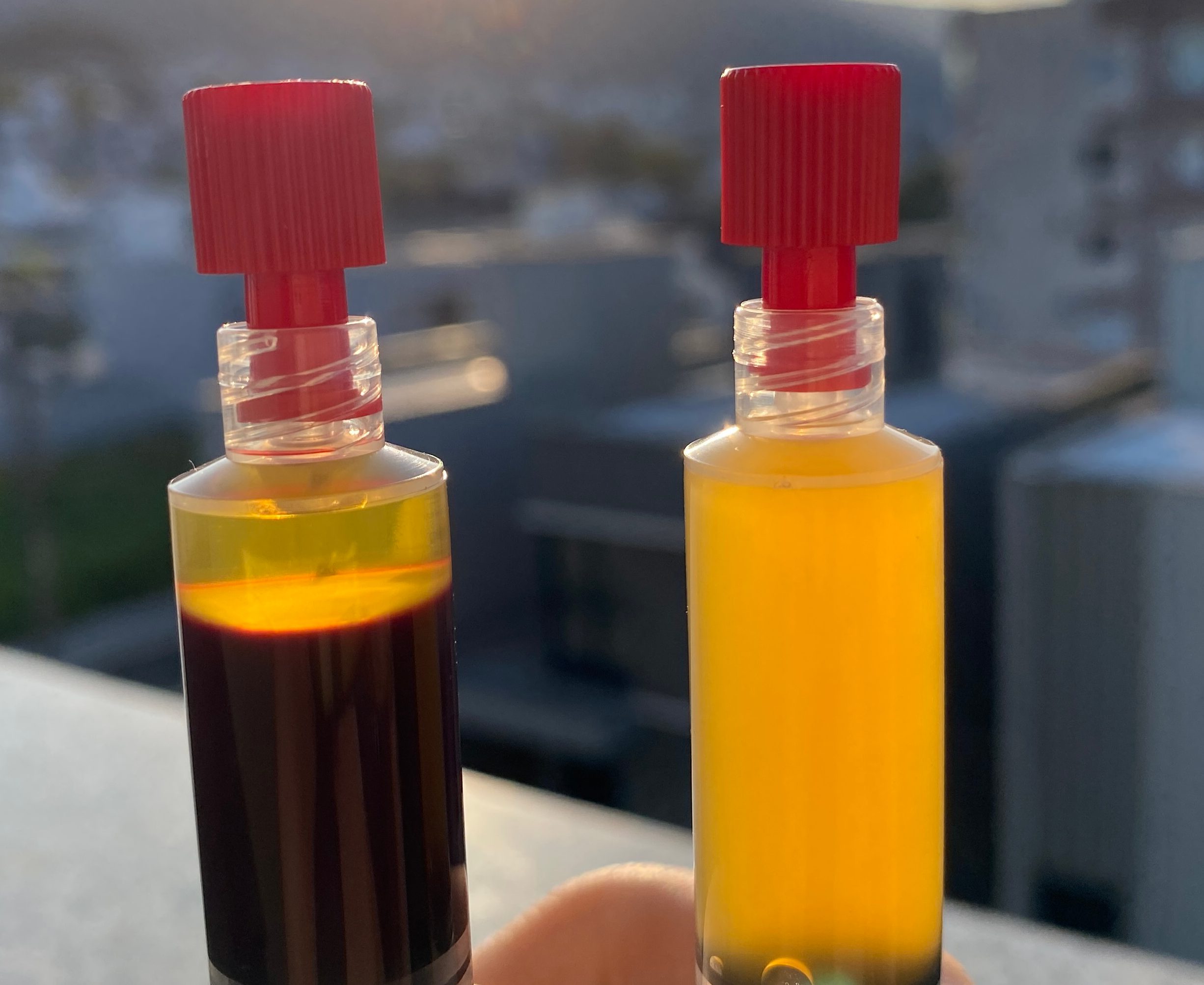Introduction
A leukocyte-poor PRP (LP-PRP) preparation was prepared using the NeutroFree PRP system’s protocol consisting of a large volume of whole blood collection and a double-spin method, accessing the buffy coat after the second spin to ensure higher platelet recovery.
Process Overview
Process Steps
- Whole Blood Collection:
- ACD-A anticoagulant is used in a 1:9 ratio for the collection. Two 60 mL syringes are each filled with 3 mL of ACD-A anticoagulant. For more information about ACD-A and its formulation, read our post here.
- 27 mL of whole blood is then collected into each of the two 60 mL syringes (30 mL of content in each).
- One syringe collected 28 mL of whole blood, and a 1 mL baseline sample was collected for hemogram analysis.
- First Spin:
- The first spin of the 60 mL syringes is an RCF of 1,250 for 20 minutes, calculated by an Rmax of 155 mm, measured to the surface of the internal plunger of the syringe. For the centrifuge used, this was an RPM of 2,680.
- After the first spin, the PPP layer is carefully aspirated but left remaining are a few mLs of plasma, ensuring that the buffy coat is not disturbed, and then a 1 mL sample of the aspirated PPP was collected for hemogram analysis.
- Buffy Coat Extraction:
- After the PPP aspiration, the erythrocyte/buffy coat interface remains intact and ready for extraction.
- The remaining PPP and buffy coat are then extracted along with a small amount of the erythrocyte layer (10 mL) into a new 20 mL syringe, ensuring the entire buffy coat and remaining platelets are collected for the second spin.
- Second Spin:
- The second spin is performed with a 20 mL syringe with an RCF of 380 for 5 minutes, calculated by an Rmax of 142 mm, measured to the surface of the internal plunger of the syringe. For the centrifuge used, this was an RPM of 1,550.
- After the second spin, the plasma layer, now 5 mL of highly concentrated PRP, is aspirated, again stopping short of the erythrocyte interface to avoid dilution and collection of granulocytes.
- A 1 mL sample of the 5 mL of prepared LP-PRP is collected for hemogram analysis.
- If activation of the platelets is required, read through our post about platelet activation methods.






Hemogram Observations
PRP Observations
- Concentration factor of 6.82x in a 5 mL of prepared PRP.
- High platelet recovery by over 56%.
- Over 4.4 billion platelets to provide efficacious therapy.
- Erythrocyte reduction by nearly 100%.
- Granulocyte reduction by nearly 100%.
- Leukocytes (granulocytes, lymphocytes, monocytes) all significantly reduced by over 90%.
PPP Observations
- Virtually 100% of erythrocytes and leukocytes unsuspended from plasma.
- PPP is virtually devoid of cells.
- Low platelet loss of only 8.3%.
Platelet Isolation Analysis
The following images demonstrate the platelet isolation process from leukocytes. To generate the remaining RBC, WBC, and PPP sample picture below in images 3 and 4, the remains were homogenized again and spun with the same RCF and time that produced the PRP. What we can identify here is that the plasma is devoid of suspended platelets, as they’ve been successfully isolated into another syringe and confirms what remains in the buffy coat are the heaviest WBCs and the RBCs below.





Materials
The materials needed to prepare Leukocyte-Poor Platelet-Rich Plasma (LP-PRP) vary depending on whether post-centrifugation analysis (e.g., hemogram, cell counts) is required. For anyone seeking to validate their preparations through laboratory analysis, additional supplies such as hematology analyzers, vacutainers, and micropipettes are necessary. However, for straightforward clinical use without laboratory validation, the minimum required equipment is much simpler. The list of required items grows substantially in more advanced configurations, as seen below:

At its most basic, LP-PRP preparation only requires the following:

Materials:
- Sterile Gloves
- Sterile Wipe
- ACD-A Anticoagulant Solution
- 25 x 0.70 mm (22G x 1) Needle
- 60 mL Leur Lock Syringe
- 60 mL Leur Lock Syringe
- Sterile Wipe
- 20 x 0.80 mm (21G x 0.75) Butterfly Scalp Needle
- Three-way Stopcock
- Band-aid (Medium)
- Sterile Gauze
- Band-aid (Small)
- Leur Lock Cap
- Leur Lock Cap
- 60 mL Leur Lock Syringe
- Three-way Stopcock
- Leur Lock Cap
- 10 mL Leur Lock Syringe
- Leur Lock Cap
- 10 mL Leur Lock Syringe
- Leur Lock Cap
- Leur Lock-to-Leur Lock Transfer Connector
- 10 mL Leur Lock Syringe
- Leur Lock Cap
Extra Items (Not pictured):
- Tourniquet
- Garden Shears
- Cup with tap water (for counterweights)
- Scale
- Bucket inserts
- Centrifuge
Platelet Recovery & Quantity vs Concentration Factor
Platelet Recovery & Quantity
The percentage of platelets recovered from the whole blood and the final platelet count of the prepared PRP are more precise indicators of the concentration system’s therapeutic efficacy and concentration efficiency. Final concentration factor is an unreliable means for determining the viability of any PRP system, as the concentration factor is determined by final volume, which can be easily manipulated.
Higher platelet counts in PRP preparations have been shown to enhance the healing of soft tissues and reduce recovery times in orthopedic and sports medicine applications. The therapeutic benefits of PRP are directly related to the quantity of platelets (the dosage) and the subsequent availability of growth factors at the site of injury.
Concentration Considerations
PRP concentration factors are determined by the quantity of platelets and the volume of the PRP preparation. A higher volume will dilute the final concentration factor. Prepared PRP volume is determined by the PPP left remaining after the first spin’s aspiration. This PRP preparation created 5 mL of LP-PRP with a platelet count of 4.435 billion platelets leading to a concentration factor of 6.82x. Possible volume preparations and concentration factors:
- 5 mL of PRP (4.435 billion platelets) = 6.82x
- 4 mL of PRP (4.435 billion platelets) = 8.53x
- 3 mL of PRP (4.435 billion platelets) = 11.37x
- 2 mL of PRP (4.435 billion platelets) = 17.06x
- 1 mL of PRP (4.435 billion platelets) = 34.12x
As can be seen, the concentration factor may not be as important as the overall platelet count.
Why Leukocyte-poor PRP?
The NeutroFree PRP system’s primary function is to create high-quality leukocyte-poor PRP (LP-PRP), which is superior for intra-articular applications where inflammation is counterproductive. Inflammation can exacerbate joint damage and hinder the healing process. Certain leukocytes, particularly neutrophils and macrophages, release cytokines like IL-1 and TNF-α, which contribute to inflammation and cartilage breakdown in joints. By reducing the leukocyte content, LP-PRP minimizes the release of these inflammatory cytokines, thereby promoting a more conducive environment for tissue repair and regeneration. This makes LP-PRP an optimal choice for treating joint conditions, such as osteoarthritis, where controlling inflammation is crucial for effective healing.
Benefits of the NeutroFree PRP System
Low Cost
An interesting metric to consider when evaluating any PRP concentration system is the cost per billion platelets. A single preparation of PRP using this system costs approximately $16 USD. The prepared PRP has a dosage of 4.435 billion platelets making the cost-per-billion-platelets $3.61 USD.
High Platelet Recovery
Due to the system’s protocol and use of syringes, a consistently high platelet recovery of over 50% is possible.
Consistent and Precise Platelet Collection
Avoiding the use of needles for platelet collection, and relying on the precision of plungers for uniform platelet selection, the NeutroFree PRP system is able to effectively isolate the platelets from undesirable leukocytes.
Avoidance of Mechanical Activation of Platelets
By concentrating the platelets into the buffy coat and accessing them after a second spin, we can avoid the concentration of a platelet pellet that inadvertently leads to the activation of some platelets via mechanical forces from spinning.
Additional LP-PRP Preparation Images
Additional images demonstrating the system’s performance.








Baseline Whole Blood

Leukocyte-poor PRP (LP-PRP) – 6.82x

Platelet-poor Plasma (PPP)

Data Table
| Parameter | Baseline Whole Blood | PRP | PPP |
|---|---|---|---|
| RBC | 3.67 (10^12/L) | 0.03 (10^12/L) | 0.00 (10^12/L) |
| HCT | 33.8% | ||
| MCV | 92.1 fl | ||
| RDW% | 14.7 | ||
| RDWa | 78.7 fl | ||
| HGR | 10.2 g/dL | 0.2 g/dL | 0.0 g/dL |
| MCH | 27.8 pg | ||
| MCHC | 30.2 g/dL | ||
| PLT | 130 (10^9/L) | 887 (10^9/L) | 13 (10^9/L) |
| PCT | 0.1% | 0.64% | |
| MPV | 8.1 fl | 7.3 fl | |
| PDW | 12.4 fl | 11.0 fl | |
| LPCR | 19.2% | 11.5% | |
| WBC | 3.3 (10^9/L) | 1.8 (10^9/L) | 0.0 (10^9/L) |
| LYM | 1.5 (45%) | 1.6 (90.7%) | |
| GRAN | 1.5 (44.4%) | 0.1 (5.6%) | |
| MTD | 0.3 (10.6%) | 0.1 (3.7%) | |
| Total Platelets (in 10^9) | 7.800 | 4.435 | 0.065 |
| Recovery Percentage of Platelets | 56.86% | ||
| Reduction % RBC | 99.93% | 100% | |
| Reduction % WBC | 95.45% | 100% | |
| Reduction % LYM | 91.11% | 100% | |
| Reduction % GRAN | 99.44% | 100% | |
| Reduction % MTD | 97.22% | 100% | |
| Recovery Percentage of WBC | 4.55% | 0% | |
| Platelet Concentration | 6.82x |
References
- Mishra, A., et al. (2014). Platelet-rich plasma in orthopedic applications: evidence-based recommendations for treatment. Journal of the American Academy of Orthopaedic Surgeons, 22(18), 469-470.
- Sundman, E. A., et al. (2014). The anti-inflammatory and matrix restorative mechanisms of platelet-rich plasma in osteoarthritis. American Journal of Sports Medicine, 42(1), 35-41.
- Riboh, J. C., et al. (2016). Effect of leukocyte concentration on the efficacy of platelet-rich plasma in the treatment of knee osteoarthritis. American Journal of Sports Medicine, 44(3), 792-800.


Leave a Reply